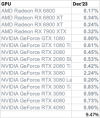snc
Veteran
11m for two companies and people wonder why sony relasing pro modelJust for fun I just counted up the number of GPU's that are roughly at or above the expected capability of the PS5 Pro (3080/6800XT and above) and that comes to about 8.4% or over 11 million PC's. Obviously that number will be a good chunk higher by the time the Pro launches, particularly with the launch of the 4xxx Super series in the interim.
So if it took a little over 3 years for the PS4 Pro to hit 14m units, even if the PS5 Pro sells as well (which seems unlikely), its highly probable to be trailing the PC in unit terms at an equivalent or higher performance level.
Consider too that if the Pro launches in Sep this year then it's likely to be followed with a couple of months by the NV 5xxx series and AMD RDNA4.


